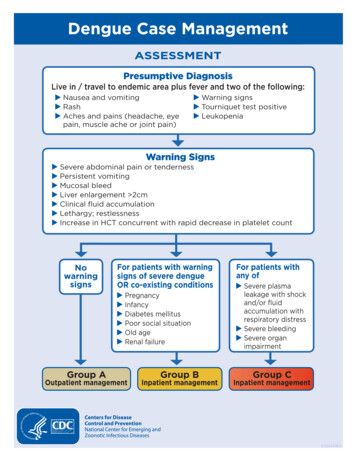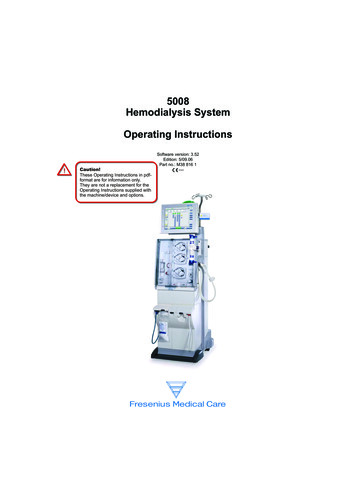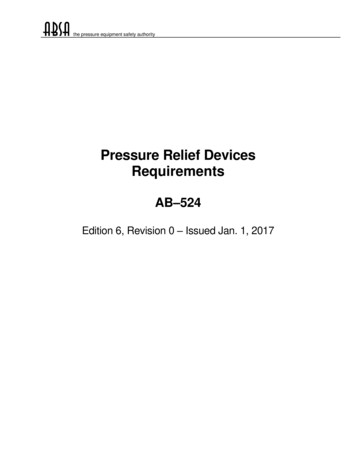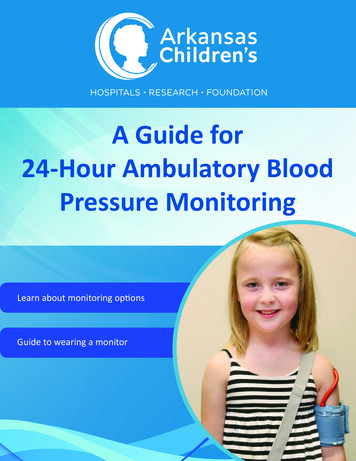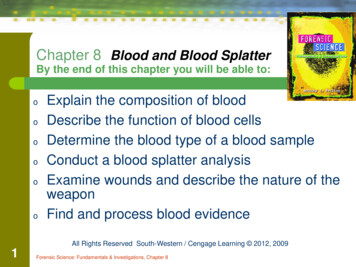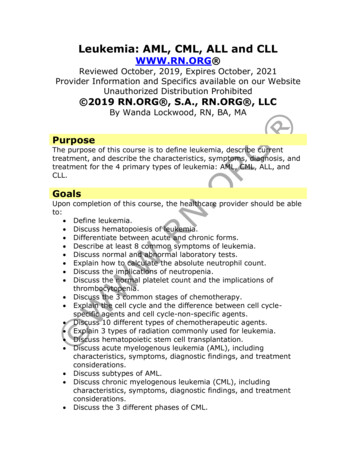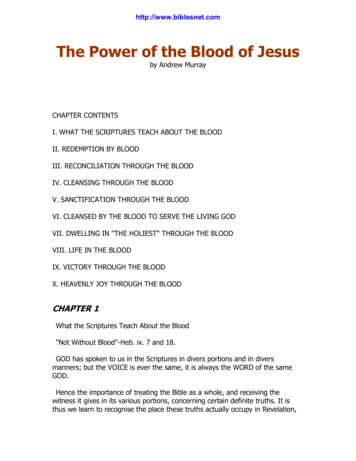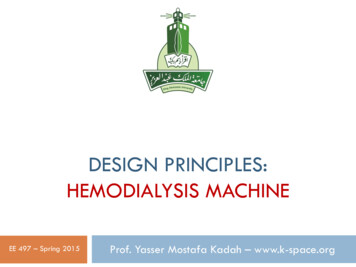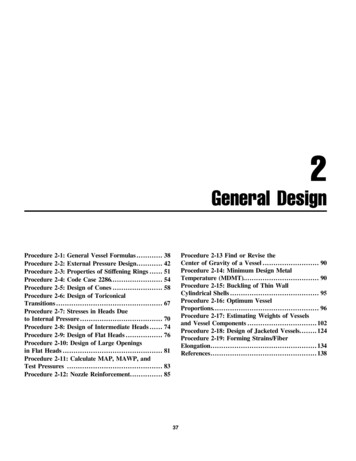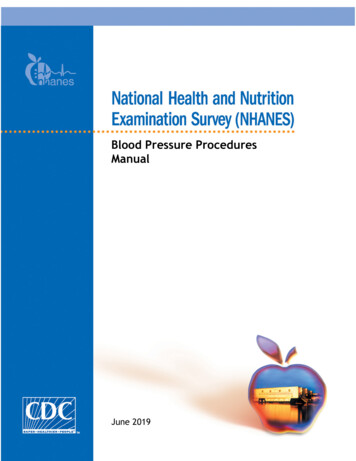
Transcription
Blood Pressure ProceduresManualJune 2019
Table of ContentsChapter1PageOverview of Blood Pressure .1-11.11.21-1Importance of Blood Pressure Measurement .Physiological/Anatomical Basis of BP Readings (Systolicand Diastolic) .1.2.1Non-Invasive Brachial Blood PressureAssessment .Clinical vs. Standardized BP Readings.1-31-3Training .1-51.2.21.31.3.11.3.21.3.31.421-1Cleaning, Setting Up the Device, and Calibrationfor Accurate Standardized Readings(See Chapter 2) .Skills to Obtain Standardized Brachial BPMeasurement (See Chapter 3) .Data Entry-Related Skills (See Chapter 3) .1-51-51-6Risk .1-7References .1-8Equipment and Supplies .2-12.1List of Equipment and Supplies for Blood Pressure .2-12.1.1List of Equipment .2-1Description of Equipment for Blood Pressure .2-12.22.2.12.2.22.2.32.2.42.3Omron IntelliSense Blood Pressure Monitor(HEM-907XL).Display Items on Omron BP Monitor .Accessories for the Omron BP Monitor(HEM-907XL).Supplies and Materials for Blood Pressure .2-12-32-42-5Equipment Care and Maintenance .2-72.3.12-8Procedure to Verify the Function Settings .iiiBlood Pressure Procedures Manual 2019
Contents ol .3-13.13.2Introduction to the Blood Pressure Measurement .Procedures for Blood Pressure Measurement .3-13-13.2.13.2.23-23-23.34Annual Calibration Check.Inventory .Equipment Malfunctions .SPs Excluded from Blood Pressure .Steps to Obtain Blood Pressure .Special Considerations.3-213.3.13.3.23.3.33-213-213-22SPs in Street Clothes .Comprehension or Language Difficulties .Interruptions.Data Entry Screens .4-14.14.24.34.44.54.64-14-34-64-84-114-14General Screen Information .Arm Circumference Screen .Data Capture Screens .Error Code/Restart Screen .Blood Pressure Statement Screen .Blood Pressure Component Status Screen.Referrals and Report of Findings .5-15.1Blood Pressure Referrals .5-15.1.15.1.2Blood Pressure Referrals—Adults .Blood Pressure Referrals—Children.5-15-3Quality Control .6-16.1Equipment and Room Setup Checks .6-16.1.16.1.26.1.36-26-36-3Daily.Weekly .Start of Stand .ivBlood Pressure Procedures Manual 2019
Contents (continued)ChapterPage6.1.46.1.56.2End of Stand .Incomplete QC Checks .6-46-4Changing Set Values for the BP Monitor .6-46.2.16.2.26.2.36.36.4Changing/Confirming the Number ofMeasurements (F1) .Waiting Time Until the Start of the FirstMeasurement (F2).Measurement Interval (F3) .6-56-56-5Recording the Serial Number of the Monitor .Observations, Replication, and Review .6-66-6AChild Blood Pressure Values.A-1BChild Blood Pressure References .B-1CAdult Blood Pressure Reference Tables.C-1DBlood Pressure Quick Tips .D-1EBlood Pressure Talking Points .E-1FBlood Pressure Recording Form .F-11-1Factors affecting accurate BP readings.1-41-2Skills matrix* .1-62-1Arm circumference and corresponding cuff size .2-52-2Summary of key functions.2-83-1Arm circumference and corresponding cuff size .3-123-2List of error codes .3-18AppendixesTablesvBlood Pressure Procedures Manual 2019
Contents (continued)TablesPage5-1Referral levels for blood pressure (adults)1 .5-15-2Blood pressure referral levels, category, and action guideline(adults) .5-25-3Adults blood pressure referral letter comments.5-25-4Table of blood pressure Report of Findings comments (adults).5-35-5Referral comments for blood pressure (children) .5-45-6Table of blood pressure Report of Findings comments (children) .5-41-1Systolic and diastolic blood pressure .1-21-2Brachial artery.1-21-3Oscillometric blood pressure .1-32-1Omron HEM-907XL BP monitor (main unit) .2-22-2Display items and buttons on the Omron HEM-907XL BPmonitor.2-32-3Battery pack, ac adapter, and air tube .2-42-4BP arm cuffs .2-52-5Supplies for blood pressure.2-62-6Foam pads.2-72-7Function settings.2-83-1Attaching the Omron to the AC adapter .3-43-2P-SET and MODE selections .3-4ExhibitsviBlood Pressure Procedures Manual 2019
Contents (continued)ExhibitsPage3-3Connecting the air tube.3-53-4Display of arm circumference measurement in blood pressure .3-63-5Upper arm bony landmarks .3-73-6Marking spine extending from acromion process .3-83-7CORRECT tape placement for upper-arm length .3-83-8INCORRECT tape placement for upper-arm length .3-83-9Marking upper-arm length midpoint .3-93-10Measurement of mid-arm circumference .3-93-11Brachial artery.3-113-12Locating the brachial artery .3-113-13Marking the brachial pulse .3-113-14Applying the blood pressure cuff .3-123-15Wrapped blood pressure cuff .3-133-16Correct position for blood pressure measurements .3-143-17Foot and arm foam pads .3-153-18How to start the blood pressure measurements .3-163-19How to deflate the blood pressure cuff .3-174-1Login SP screen .4-14-2ISIS screen characteristics .4-24-3Arm Circumference screen .4-34-4Intake and Arm Circumference screen.4-4viiBlood Pressure Procedures Manual 2019
Contents (continued)ExhibitsPage4-5Cuff size .4-54-6Out of range confirmation message.4-54-7Intake Question .4-54-8Data Capture Screen 1 with values .4-64-9Data Capture Screen 2 with inconsistent readings from Screen 1 .4-74-10Data Capture Screen 3 .4-74-11Data Capture Screen 3 – with corrected values .4-84-12Error code.4-94-13Error code numbers .4-94-14Rest period re-started .4-104-15BP measures re-started .4-114-16BP Statement - normal .4-124-17BP Statement - high .4-124-18BP Statement – very high .4-134-19BP Statement – severely high.4-134-20Blood Pressure Component Status screen – complete .4-144-21Blood Pressure Component Status screen – partial .4-156-1Quality control daily checks .6-26-2Quality control weekly checks .6-36-3Quality control start of stand checks .6-36-4Quality control end of stand checks .6-46-5Quality control equipment swap .6-6viiiBlood Pressure Procedures Manual 2019
Overview of Blood Pressure1Blood pressure (BP) will be monitored in the current National Health and Nutrition ExaminationSurvey (NHANES) by the mobile examination center (MEC) health technicians (HT). HTs willobtain BP values using an oscillometric device (Omron HEM-907XL) on participants aged 8 yearsand older.1.1Importance of Blood Pressure MeasurementRecently, the Global Burden of Disease report identified elevated systolic blood pressure as one ofthe 10 largest contributors to disability-adjusted life years lost during 2015 (1). Effective BPmanagement, resulting in a reduction in BP values, has been shown to decrease the incidence ofmortality, stroke, heart attack, and heart failure (2–3). Accurate and reliable BP measurement is thekey to providing valid national hypertension estimates, and hence, helping to reduce the burden ofcardiovascular diseases in the U.S.1.2Physiological/Anatomical Basis of BP Readings (Systolicand Diastolic)Blood pressure is measured using two numbers. The first number, defined as systolic, is themeasurement exerted by the blood as it flows through the arteries as the result of contraction(pumping) of the ventricles. The second number, defined as diastolic, is the pressure exerted on thearteries when the ventricles are at rest and filling with blood (Exhibit 1-1).1-1Blood Pressure Procedures Manual 2019
Overview of Blood PressureExhibit 1-1.1Systolic and diastolic blood pressureSystolic Blood PressureSystole (pumping)Diastolic Blood PressureDiastole (filling)Unless indicated otherwise, blood pressure refers to the pressure in the large arteries deliveringblood to body parts other than the lungs, such as the brachial artery (in the arm). Arteries are mostlylocated inside our body, which makes them difficult to palpate. In contrast, the brachial artery isclose to the surface of the skin, easy to find and palpate with our fingers. When a person is in asitting position, the brachial artery is approximately at the same height as the heart, and it is locatedabove a large muscle (the biceps muscle), which provides a hard surface to compress the brachialartery against (Exhibit 1-2).Exhibit 1-2.Brachial artery1-2Blood Pressure Procedures Manual 2019
Overview of Blood Pressure1.2.11Non-Invasive Brachial Blood Pressure AssessmentNon-invasive brachial blood pressure assessment can be broadly categorized as usingauscultatory/manual technology (mercury column or aneroid manometer) or oscillometrictechnology (automated devices) to obtain BP readings (4). Auscultatory/manual BP devices havebeen phased out in recent years due to intensive training to accurately obtain BP, increasedenvironmental concerns about the disposal of mercury-contaminated medical waste, and the risk ofspills from mercury sphygmomanometers (5). Oscillometric BP devices estimate systolic BP (SBP)and diastolic BP (DBP) from the mean arterial pressure using a device-specific algorithm and theoscillometric pulse waves detected in the BP cuff, typically during deflation, although some devicesassess BP during inflation. Each manufacturer of oscillometric devices incorporates its ownundisclosed proprietary algorithm(s) for estimating SBP and DBP (4). Exhibit 1-3 depicts anoscillometric blood pressure curve showing BP cuff inflation as deflation for a single BPmeasurement. The cuff is automatically inflated by the pump when the BP measurement is initiated.The cuff pressure increases to 180 millimeters of Mercury (mmHg) over 10 seconds, the pumpstops, and the electronic valves control the deflation from 180 mmHg to a pressure below diastolicpressure. The total measurement time is approximately 36 seconds (4).Exhibit 1-3.1.2.2Oscillometric blood pressureClinical vs. Standardized BP ReadingsBP can be observed in a clinic such as in a health care providers’ office or in a research setting, suchas in the National Health and Nutrition Examination Survey. Because of the need to generalize theU.S. population, standardized reproducible training and procedures are absolutely essential foraccurate BP observations. Stated differently, in order to extrapolate from the survey sample to the1-3Blood Pressure Procedures Manual 2019
Overview of Blood Pressure1United States non-institutionalized population, all BP observations need to be done repeatedly in thesame manner. Table 1-1 lists factors that can affect accurate systolic BP (SBP) and diastolic BP(DBP) readings.Table 1-1.Factors affecting accurate BP readingsDeviceOmron HEM-907XLValidationIt is designed and used as a clinical BP monitor. It passed the AAMIvalidation criteria and was cleared by the FDA (7-10). Also, it has beenused in numerous adult CVD/epidemiological studies including thefollowing: a) the action to control cardiovascular risk at diabetes(AACORD); b) the systolic BP intervention trial (SPRINT); c) the NHLBICoronary Artery Risk Development in Young Adults (CARDIA); d) theArkansas Cardiovascular Health Examination Survey (ARCHES); e) theSurvey of the Health of Wisconsin (SHOW); and f) the Oregon HealthStudy Group (11-15).Effect on SBP, mmHgEffect on DBP, mmHgObtaining BPIndividual PositioningStanding versus sitting-2.9 to 5.0Supine versus sitting-10.7 to 9.5Legs crossed at the knee 2.5 to 14.9Unsupported backNot significant effectsUnsupported arm 4.9Arm lower than heart level 3.7 to 23Attaching the Device to the IndividualToo small cuff size 2.1 to 11.2Too large cuff size-3.7 to -1.5Not significant effectsCuff placed over clothing1Talking during the measurement 4 to 19Not significant effectsShort interval betweenmeasurements2Interpreting the MeasurementReliance on a single 3.3 to 10.4measurement 7-13.4 to 6.4 1.4 to 10.8 6.5 2.7 to 4.8 2.8 to 12 1.6 to 6.6-4.7 to -1.0Not significant effects 5 to 14.3Not significant effects-2.4 to 0.6Notes:1Our study participants were dressed in examination gowns, and the Omron 907XL was validated on a bare, mid-upper arm.2Since the advance of oscillometric BP devices, very few studies challenging the 1-minute waiting assumption appeared in the peerreviewed literature. Stated differently, the 1-minute rule is based on the auscultatory measurement method, which may not apply torapidly deflating automatic BP devices. Eguchi et al. 2009 used a convenience sample of 56 hypertensive patients aged 18 years andolder with a mean age of 56 years; 46.4 percent were men. Their results showed that 10-second interval readings were statisticallysignificantly higher than 1-minute readings for systolic only ( 3 mmHg) and the 1-minute systolic readings were closer to awake ABPsystolic readings. On the other hand, Yarows et al. 2001 used a convenience sample of 50 normotensive and hypertensive individualsaged 18 years and older with a mean age of 50; 55 percent were men. Their results showed that 15-second interval readings were notstatistically significantly higher than 1-minute readings for systolic (-1.3 mmHg) and diastolic (-0.1 mmHg) (16).1-4Blood Pressure Procedures Manual 2019
Overview of Blood Pressure1.31TrainingTraining will be provided by NCHS personnel and Westat. This training will teach the healthtechnicians the rationale and skills for taking standardized BP (Table 1-2). At the end of the training,BP observer will be able to: Explain, briefly and simply, the physiological/anatomical basis of BP readings (systolicand diastolic); Explain the concept of clinical vs. standardized BP readings; Describe factors affecting accurate BP readings; Demonstrate and describe device-related skills; such as cleaning, setting up the device,and calibration for accurate standardized readings; Demonstrate and describe procedure-related skills to obtain standardized brachial BPmeasurement; and Demonstrate and describe data-entry related skills.1.3.1Cleaning, Setting Up the Device, and Calibration for AccurateStandardized Readings (See Chapter 2) Cleaning; Device settings for obtaining BP; Calibration.1.3.2Skills to Obtain Standardized Brachial BP Measurement (SeeChapter 3) Explain the procedure; Take BP on bare, upper-right arm (or upper-left arm if unable to obtain BP on theupper-right arm); Obtain the individual’s mid-arm circumference; Select correct BP cuff size matching the mid-arm circumference range;1-5Blood Pressure Procedures Manual 2019
Overview of Blood Pressure1 Position the individual in the chair, back and arm supported, with legs uncrossed andboth feet flat on the floor; Position the middle of the cuff on the individual’s mid-upper arm at the level of theright atrium (the midpoint of the sternum); Complete rest period of at least 5 minutes with no talking, mobile phone usage, orreading; Take three BP measurements one minute apart with no talking, mobile phone usage, orreading.1.3.3Data Entry-Related Skills (See Chapter 3) Integrated Survey Information System (ISIS) data entry; Double key the BP data; Inform the SP about the results, including the possibility for referral to the MECphysician.Table 1-2.Skills matrix*SkillsBP device is correctly set to obtain standardized BPExplains the procedureCorrect cuff size is selected matching mid-upper arm circumferenceCuff is placed over bare, mid-upper armSP is seated with back supportedFeet flat on the floorArm is supportedBP cuff placed at the mid-upper arm and at the level of the right atriumSP rests 5 minutes sitting prior to measurementsNo talking, mobile phone usage, or reading during rest periodNo talking, mobile phone usage, or reading during BP readingsObtains 3 BP measurements (systolic and diastolic)Waits 1 minute between BP measurementsEnters data correctly (double keys data)If asked, provides BP readings to SP with explanationIf appropriate, refers the individual to see the MEC physicianYesNo*Adapted from Rakotz MK, et. al. 2017 (6).1-6Blood Pressure Procedures Manual 2019
Overview of Blood Pressure1.41RiskThere is minimal risk when performing blood pressure measurements; however, there can betransient discomfort when the blood pressure cuff inflates. Before taking blood pressuremeasurements, the HT will inform the participant that while the machine inflates the cuff, it mayfeel tight and the participant may feel some pressure. The oscillometric device has an instantdeflation button and a stop button that can be used if a participant complains about uncomfortablepressure.1-7Blood Pressure Procedures Manual 2019
Overview of Blood Pressure1References1.GBD 2015 Risk Factors Collaborators. Global, regional, and national comparative riskassessment of 79 behavioral, environmental and occupational, and metabolic risks or clustersof risks, 1990–2015: a systematic analysis for the global burden of disease study 2015. Lancet2016; 388:1659–1724.2.Chobanian AV, Bakris GL, Black HR, Cushman WC, Green LA, Izzo JL Jr, Jones DW,Materson BJ, Oparil S, Wright JT Jr, Roccella EJ; Joint National Committee on Prevention,Detection, Evaluation, and Treatment of High Blood Pressure. National Heart, Lung, andBlood Institute; National High Blood Pressure Education Program Coordinating Committee.Seventh report of the Joint National Committee on prevention, detection, evaluation, andtreatment of high blood pressure. Hypertension 2003; 42:1206–1252.3.Ambrosius WT, Sink KM, Foy CG, Berlowitz DR, Cheung AK, Cushman WC, Fine LJ, GoffDC Jr, Johnson KC, Killeen AA, Lewis CE, Oparil S, Reboussin DM, Rocco MV, Snyder JK,Williamson JD, Wright JT Jr, Whelton PK; SPRINT Study Research Group. The design andrationale of a multicenter clinical trial comparing two strategies for control of systolic bloodpressure: the systolic blood pressure intervention trial (SPRINT). Clin Trials 2014; 11:532–546.4.Alpert BS, Quinn D, Gallick D. Oscillometric blood pressure: a review for clinicians. J AmSoc Hypertens. 2014 Dec;8(12):930-8. doi: 10.1016/j.jash.2014.08.014.5.Environmental Working Group, Health Care Without Harm. Protecting by degrees: whathospitals can do to reduce mercury pollution. 1999. Available df.6.Rakotz MK, Townsend RR, Yang J, Alpert BS, Heneghan KA, Wynia M, Wozniak GD.Medical students and measuring blood pressure: results from the American MedicalAssociation Blood Pressure Check Challenge. J Clin Hypertens (Greenwich). 2017Jun;19(6):614-619. doi: 10.1111/jch.13018. Epub 2017 Apr 28.7.White WB, Anwar YA. Evaluation of the overall efficacy of the Omron office digital bloodpressure HEM-907 monitor in adults. Blood Press Monit. 2001; 6(2):107-10.8.El Assaad MA, Topouchian JA, Darné BM, Asmar RG. Validation of the Omron HEM-907device for blood pressure measurement. Blood Press Monit. 2002; 7(4): 237-41.9.Ostchega Y, Zhang G, Sorlie P, Hughes JP, Reed-Gillette DS, Nwankwo T, Yoon S. Bloodpressure randomized methodology study comparing automatic oscillometric and mercurysphygmomanometer devices: National Health and Nutrition Examination Survey, 2009-2010.Natl Health Stat Report. 2012; (59):1-15.10.Ostchega Y, Nwankwo T, Sorlie PD, Wolz M, Zipf G. Assessing the validity of the OmronHEM-907XL oscillometric blood pressure measurement device in a National Surveyenvironment. Clin Hypertens (Greenwich). 2010 Jan;12(1):22-8.1-8Blood Pressure Procedures Manual 2019
Overview of Blood Pressure111.Ginsberg HN. The ACCORD (Action to Control Cardiovascular Risk in Diabetes) lipid trial:what we learn from subgroup analyses DIABETES CARE, VOLUME 34, SUPPLEMENT 2,MAY 2011 doi: 10.2337/dc11-s203.12.Ambrosius WT, Sink KM, Foy CG, Berlowitz DR, Cheung AK, Cushman WC, Fine LJ, GoffDC Jr, Johnson KC, Killeen AA, Lewis CE, Oparil S, Reboussin DM, Rocco MV, Snyder JK,Williamson JD, Wright JT Jr, Whelton PK; SPRINT Study Research Group. The design andrationale of a multicenter clinical trial comparing two strategies for control of systolic bloodpressure: the Systolic Blood Pressure Intervention Trial (SPRINT). Clin Trials. 2014Oct;11(5):532-46. doi: 10.1177/1740774514537404.13.National Heart, Lung, and Blood Institute (NHLBI) 2014. The Coronary Artery RiskDevelopment in Young Adults study (CARDIA). Retrieved esity/population/index.htm14.Zohoori N, Pulley L, Jones C, Senner J, Shoob H, Merritt RK. Conducting a statewide healthexamination survey: the Arkansas Cardiovascular Health Examination Survey (ARCHES).Prev Chronic Dis. 2011; 8(3): A67.15.Nieto FJ, Peppard PE, Engelman CD, McElroy JA, Galvao LW, Friedman EM, Bersch AJ,Malecki KC. The Survey of the Health of Wisconsin (SHOW), a novel infrastructure forpopulation health research: rationale and methods. BMC Public Health. 2010 23; 10:785.16.Yarowsa SA, Patelb K., Brooka R. Rapid oscillometric blood pressure measurement comparedto conventional oscillometric measurement. Blood Pressure Monitoring 2001, 6:145–147.1-9Blood Pressure Procedures Manual 2019
Equipment and Supplies2.1List of Equipment and Supplies for Blood Pressure2.1.1List of Equipment2The equipment used for the blood pressure component is listed below: Omron IntelliSense Blood Pressure Monitor (Model: HEM-907XL) Omron Battery Pack (Model: HEM-907-PBAT) AC Adapter (Model HEM-ADPT907) Air Tube 1.3m (Model: HEM-TUBE-130XL) Cuff/bladder set: Extra Large (Model: HEM-907-CX19) Cuff/bladder set: Large (Model: HEM-907-CL19) Cuff/bladder set: Medium (Model: HEM-907-CR19) Cuff/bladder set: Small (Model: HEM-907-CS19)2.2Description of Equipment for Blood Pressure2.2.1Omron IntelliSense Blood Pressure Monitor (HEM-907XL)The Omron IntelliSense Blood Pressure Monitor (Model: HEM-907XL) will be used to measureblood pressure (BP) (see Exhibit 2-1). The Omron BP monitor is developed to measure bloodpressure and pulse rate accurately and simply in a clinical setting.2-1Blood Pressure Procedures Manual 2019
Equipment and SuppliesExhibit 2-1.2Omron HEM-907XL BP monitor (main unit)2-2Blood Pressure Procedures Manual 2019
Equipment and Supplies
above a large muscle (the biceps muscle), which provides a hard surface to compress the brachial artery against (Exhibit 1-2). Exhibit 1-2. Brachial artery . 1-2 Blood Pressure Procedures Manual 2019. . auscultatory/manual
